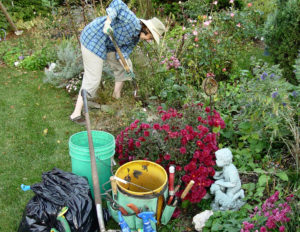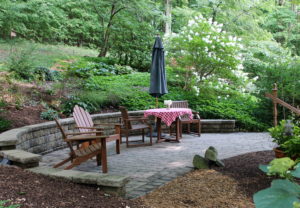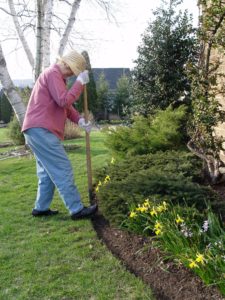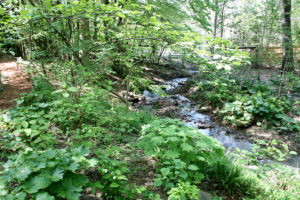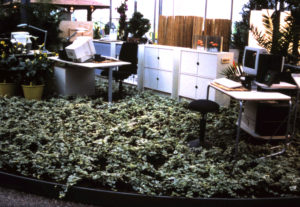Why We Needed Our Gardens More than Ever This Year
November 3rd, 2020
A surprising twist happened this year on the way to a pandemically doomed gardening season.
It actually turned out to be one of the best years ever for plant sales.
Everybody from seed companies to garden centers to landscapers are reporting banner years – some of them record years.
It seems that many of us retreated into our yards and took solace in one of the few spots that seemed safe and familiar – our gardens. And we bought a whole lot of plants in the process.
“Time and time again, we heard people say they were tired of being cooped up, and they wanted to get out and enjoy the outdoors,” said Veto Barziloski, who owns Bennies Nursery in the Wyoming County countryside near Scranton.
He says fresh air and exercise were only part of the allure, though.
“Gardening is therapeutic,” Veto says. “I think it’s been a mental and emotional relief for people, too.”
How true. Gardening is something people turn to whenever the chips are down.
“If you go back to other times of uncertainty, you generally see an uptick in gardening sales,” says Chris Wallen, a grower at the wholesale Quality Greenhouses near Dillsburg. “This year, it was all over the board. People bought everything.”
I was talking to David Wilson about this, and he says he’s seen the same thing.
David has long been the gardener-educating horticulturist for Overdevest Nurseries, which produces the Garden Splendor line of plants. But he grew up and got his career start in Ireland, which back then was frequently rocked by internal terrorism and violence.
Every time terrorism flared, he says, gardening peaked.
“When people feel threatened or insecure, they go into the garden more,” Wilson says. “People feel safe in their garden.”
In the case of COVID-19, people have been reluctant to venture out – and at times have been urged to stay home. The open air and isolation of our own yards seemed like a very good place to be.
Glued to home, we paid more attention to what we had – or lacked, says Erica Shaffer, the former long-time manager at Highland Gardens who’s now doing garden designs and working for Black Landscape Center.
“People are seeing more than usual, noticing how overgrown or sickly their plants have begun to look, or noticing areas that need screening, or thinking about that dream they’ve always had about a patio,” she says. “Some said they had been chatting about the changes for years and just never got around to it.”
This year they did. And lots hired landscapers to put in those patios, especially ones with fireplaces or firepits to sit around, says Ted Ventre, owner of Hively Landscapes in Dover.
“I think every design we did this year had a fire feature of some sort,” he says.
Besides having more time, those who didn’t lose jobs or income found themselves with money that could be diverted into plants or landscaping projects (or any home-related project, for that matter).
“People were not going on vacation, they were not eating out, and so they had disposable income,” Wilson says.
But even those with tighter budgets were inclined to invest in some flowers, although flowers are more luxury than necessity. Or are they?
“If people are getting depressing news, they look for something to brighten their life,” says Wilson.
A few flowers are an affordable way to do that.
As Janeen Wright, editor of Greenhouse Grower magazine, put it in a July article: “The pandemic has helped the horticulture industry do what we’ve been scratching our heads about for years – how to get people to realize they can’t live without plants.”
Shaffer agrees. “It was like a NEED for gardening kicked in as we all began to spin too quickly,” she says.
I heard similar stories from gardeners, as many of you said you’ve never appreciated and treasured your gardens as much as this year.
Maybe there’s some kind of primordial urge in at least some of us to dig in the dirt and to marvel at how those little seedlings grow into big, beautiful flowers.
Maybe gardening is just comforting.
One thing is for sure. Gardening delivers all sorts of measurable health benefits – mental and emotional as well as physical.
While browsing through recent writings in the Journal of Environmental Horticulture (yes, I’m that much of a gardening egghead), I happened across an interesting roundup of dozens of studies that have been done in the last eight years that all verify the effect of plants, gardening, and green spaces on our well-being.
Since you probably don’t subscribe to that journal, here are 20 benefits backed up by research:
1.) Time spent in natural settings helps reduce mental fatigue and improve concentration levels, decrease anxiety, lower heart rates, and lead to positive changes in nerve activity.
2.) For patients in hospitals, exposure to real plants or even posters of plants, results in lower levels of stress.
3.) The amount of green space in a neighborhood, and in particular access to a garden, are significant predictors of stress. People have both lower mental distress and higher levels of well-being when living in areas with more green space compared to low-plant urban areas.
4.) In a study of elderly women who spent 15 sessions outside participating in gardening activities versus staying inside, those who had gone outside had improved muscle mass and hand dexterity and decreased waist circumference, whereas the women who stayed indoors had decreased muscle mass and agility and increased symptoms of depression.
5.) When young people, particularly students, have a view of green spaces during school, students exhibit significantly better performance on attention tests and recover from stress quicker.
6.) People with high blood pressure and pulse rate show a decrease in both after walking in a forested area.
7.) Children with ADHD concentrate better after a walk in a park than after a walk in a downtown neighborhood.
8.) Garden walking and journaling decrease depression scores in older adults.
9.) People with major depressive disorders exhibit significant increases in memory after a nature walk than when compared to an urban walk. Green spaces also reduced stress and pain and increased attention performance in that study.
10.) Residents with only 10 percent green space within a half a mile had a 25 percent greater risk of depression and a 30 percent greater risk of anxiety disorders versus those with the highest degree of green space near the home.
11.) People perform 20 percent better on memory tests after walking through a green arboretum compared to those who walked on traffic-heavy urban streets.
12.) Interacting with nature, especially with water around, increases self-esteem and mood, reduces anger, and improves general psychological well-being.
13.) Moving to homes with greener areas positively influences mental health even three years post-move, while moving to a less-green area significantly worsens mental health within one year post-move (but returns to pre-move mental health status thereafter).
14.) People living in areas rich in green public features had better mental health than those with fewer enhanced features. Positive public features include irrigated lawns, walking paths, lighting, water features, playgrounds, and bird life.
15.) Those who are more connected to nature and exhibit environmentally-conscious behaviors tend to experience more positive vitality and life satisfaction compared to those less connected to nature.
16.) People who live in neighborhoods with a higher density of street trees report significantly fewer cardiac issues. Having 10 or more trees in a city block, on average, improves personal health perceptions in ways comparable to a $10,000 increase in annual personal income or being seven years younger.
17.) Visible greenery, both indoors and out, reduces stress and increases the ability of office workers to concentrate. In one concentration test, employees who had a view of plants completed the test 19 percent faster than employees in a room without a view of plants. Offices in the Netherlands and Great Britain experienced a 15 percent increase in worker productivity when plants were included in the office.
18.) Houseplants in the workplace reduce allergies, irritations, asthma, drowsiness, and eye problems while improving mood. The study found that as few as three small-to-medium plants can make a positive difference.
19.) When integrating a school garden into the curriculum, children’s physical activity increases and sedentary behavior decreases. Children who received breaks and time outside exhibited improved concentration. Just placing plants in the classroom correlated with children progressing through school curriculum 20 to 26 percent faster.
20.) Patients who take part in outside horticultural therapy, such as gardening or landscaping, are more actively engaged, have reduced incidents of aggressive behavior, and improved thinking ability.








